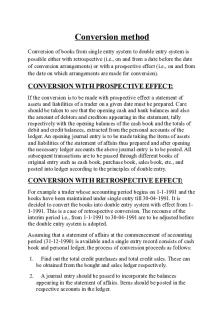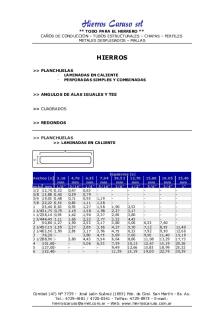BMED Conversion Sheet PDF

| Title | BMED Conversion Sheet |
|---|---|
| Author | Ella Rossiter |
| Course | Conservation Prin In Bme |
| Institution | Georgia Institute of Technology |
| Pages | 1 |
| File Size | 93.8 KB |
| File Type | |
| Total Downloads | 53 |
| Total Views | 144 |
Summary
BMED Conversion Sheet...
Description
BME 2110: Supplementary Notes Basic Constants and Conversion Factors In engineering calculations, it is often necessary to convert from one system of units to another. The first step in the solution to many problems often involves conversion of the data to a more convenient system of units. Listed below are the most common constants and conversion factors. They are encountered repeatedly – please memorize them. Na=23.0 O=16.0 S=32.0
Fe=55.8 H=1.0 K=39.1 N=14.0
Atomic weights: C=12.0 Ca=40.0 Cl=35.5 Molecular weights:
Water = 18 Glucose = 180
Amino acid, avg = 135 Dry air = 28.84
DNA base pair, avg = 610 Protein, range = 5000 to 3x106
Length:
1 m = 100 cm = 1000 mm = 106 microns (µm) = 109 nanometers (nm) = 1010 angstroms 1 in. = 2.54 cm 1 mi. = 5,280 ft = 1.61 kilometers Typical mammalian cell, diameter = 10 μ m
Mass:
1 kg = 1000 g = 0.001 metric ton = 2.2 lbm 1 lbm = 16 oz = 454 gm = 0.454 kg = 5 x 10-4 ton
Volume:
1 m3 = 1000 L = 106 cm3 = 106 mL; 1 ft3 = 7.48 gal = 28.3 L Whole blood volume = 5 L (resting cardiac output = 5 L/min) Total lung capacity = 6.0 L, tidal volume = 0.500 L, breathing frequency = 12 breaths/min
Density:
1 gm/cm3 = 62.4 lbm /ft3 = 8.33 lbm/gal 1 gm mol of an ideal gas at 0°C, 760 mm Hg = 22.4 L 1 lb mol of an ideal gas at 32°F, 14.7 psia = 359 ft3
Pressure:
1 atm = 760 mm Hg at 0°C (torr) = 14.7 lbf/in.2 (psi) 1 atm = 29.92 in. Hg = 34 ft H2O 1 atm = 1.013 bar = 101.3 kPa = 1.013 x 106 dynes/cm2; 1 Pa = 1 N/m2 Systemic blood pressure = 120/80 mmHg
Temperature:
D1.0°C = D1.8°F or 1.0°C = 1.8°F Temperature conversion between Fahrenheit and Centigrade scales by: °F = 1.8(°C) + 32 °Rankine = °Fahrenheit + 460; °Kelvin = °Centigrade + 273 Room temperature = 25° C (298K); Body core temperature = 37° C (310K)
Force:
1 lbf = 32.174 lbm×ft/s2 = 4.448 N = 4.448 kg×m/s2 = 4.448 x 105 dynes 1 N = 1 kg×m/s2 1 dyne = 1 g×cm/s2
Composition of Air:
For most engineering calculations, dry air may be considered by volume as 79% N2, 21% O2 by mole percentage as 79% N2, 21% O2. by weight percentage as 76% N2, 24% O2 .
STP
Standard temperature and pressure (0°C, 1 atm)
Molar volume of an ideal gas at STP
22.4 L/mol = 359 ft3/lbm-mole...
Similar Free PDFs

BMED Conversion Sheet
- 1 Pages

Conversion sheet
- 1 Pages

BMED 66 Chapter 14 Heart
- 7 Pages

LAB40- Conversion
- 11 Pages

Conversion method
- 4 Pages

Conversion Factors
- 1 Pages

Conversion Chart
- 1 Pages

Tablas conversion
- 2 Pages

Conversion efficiency
- 2 Pages

Tabla Conversion 129.-192
- 4 Pages

Energy Conversion Lab Sheets
- 27 Pages

Evaluación Conversion DE Angulos
- 2 Pages

Mole conversion Notes KEY
- 3 Pages

Assignment 2 Base Conversion
- 3 Pages

Land conversion - useufl
- 8 Pages
Popular Institutions
- Tinajero National High School - Annex
- Politeknik Caltex Riau
- Yokohama City University
- SGT University
- University of Al-Qadisiyah
- Divine Word College of Vigan
- Techniek College Rotterdam
- Universidade de Santiago
- Universiti Teknologi MARA Cawangan Johor Kampus Pasir Gudang
- Poltekkes Kemenkes Yogyakarta
- Baguio City National High School
- Colegio san marcos
- preparatoria uno
- Centro de Bachillerato Tecnológico Industrial y de Servicios No. 107
- Dalian Maritime University
- Quang Trung Secondary School
- Colegio Tecnológico en Informática
- Corporación Regional de Educación Superior
- Grupo CEDVA
- Dar Al Uloom University
- Centro de Estudios Preuniversitarios de la Universidad Nacional de Ingeniería
- 上智大学
- Aakash International School, Nuna Majara
- San Felipe Neri Catholic School
- Kang Chiao International School - New Taipei City
- Misamis Occidental National High School
- Institución Educativa Escuela Normal Juan Ladrilleros
- Kolehiyo ng Pantukan
- Batanes State College
- Instituto Continental
- Sekolah Menengah Kejuruan Kesehatan Kaltara (Tarakan)
- Colegio de La Inmaculada Concepcion - Cebu
